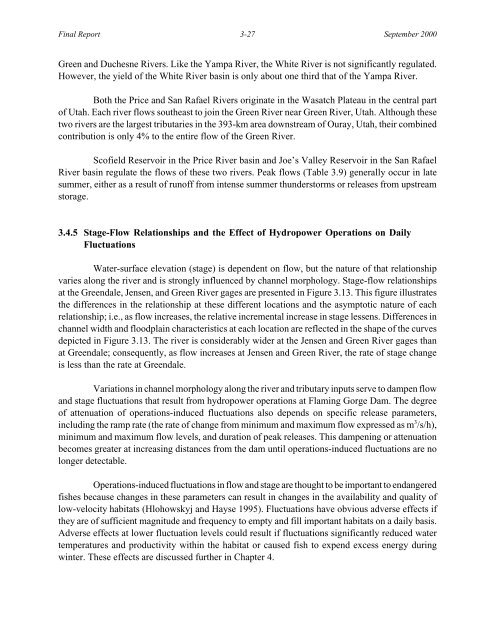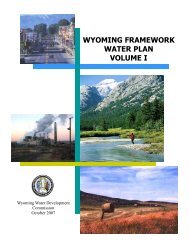Flow and Temperature Recommendations for Endangered Fishes in ...
Flow and Temperature Recommendations for Endangered Fishes in ...
Flow and Temperature Recommendations for Endangered Fishes in ...
You also want an ePaper? Increase the reach of your titles
YUMPU automatically turns print PDFs into web optimized ePapers that Google loves.
F<strong>in</strong>al Report 3-27 September 2000<br />
Green <strong>and</strong> Duchesne Rivers. Like the Yampa River, the White River is not significantly regulated.<br />
However, the yield of the White River bas<strong>in</strong> is only about one third that of the Yampa River.<br />
Both the Price <strong>and</strong> San Rafael Rivers orig<strong>in</strong>ate <strong>in</strong> the Wasatch Plateau <strong>in</strong> the central part<br />
of Utah. Each river flows southeast to jo<strong>in</strong> the Green River near Green River, Utah. Although these<br />
two rivers are the largest tributaries <strong>in</strong> the 393-km area downstream of Ouray, Utah, their comb<strong>in</strong>ed<br />
contribution is only 4% to the entire flow of the Green River.<br />
Scofield Reservoir <strong>in</strong> the Price River bas<strong>in</strong> <strong>and</strong> Joe’s Valley Reservoir <strong>in</strong> the San Rafael<br />
River bas<strong>in</strong> regulate the flows of these two rivers. Peak flows (Table 3.9) generally occur <strong>in</strong> late<br />
summer, either as a result of runoff from <strong>in</strong>tense summer thunderstorms or releases from upstream<br />
storage.<br />
3.4.5 Stage-<strong>Flow</strong> Relationships <strong>and</strong> the Effect of Hydropower Operations on Daily<br />
Fluctuations<br />
Water-surface elevation (stage) is dependent on flow, but the nature of that relationship<br />
varies along the river <strong>and</strong> is strongly <strong>in</strong>fluenced by channel morphology. Stage-flow relationships<br />
at the Greendale, Jensen, <strong>and</strong> Green River gages are presented <strong>in</strong> Figure 3.13. This figure illustrates<br />
the differences <strong>in</strong> the relationship at these different locations <strong>and</strong> the asymptotic nature of each<br />
relationship; i.e., as flow <strong>in</strong>creases, the relative <strong>in</strong>cremental <strong>in</strong>crease <strong>in</strong> stage lessens. Differences <strong>in</strong><br />
channel width <strong>and</strong> floodpla<strong>in</strong> characteristics at each location are reflected <strong>in</strong> the shape of the curves<br />
depicted <strong>in</strong> Figure 3.13. The river is considerably wider at the Jensen <strong>and</strong> Green River gages than<br />
at Greendale; consequently, as flow <strong>in</strong>creases at Jensen <strong>and</strong> Green River, the rate of stage change<br />
is less than the rate at Greendale.<br />
Variations <strong>in</strong> channel morphology along the river <strong>and</strong> tributary <strong>in</strong>puts serve to dampen flow<br />
<strong>and</strong> stage fluctuations that result from hydropower operations at Flam<strong>in</strong>g Gorge Dam. The degree<br />
of attenuation of operations-<strong>in</strong>duced fluctuations also depends on specific release parameters,<br />
<strong>in</strong>clud<strong>in</strong>g the ramp rate (the rate of change from m<strong>in</strong>imum <strong>and</strong> maximum flow expressed as m 3 /s/h),<br />
m<strong>in</strong>imum <strong>and</strong> maximum flow levels, <strong>and</strong> duration of peak releases. This dampen<strong>in</strong>g or attenuation<br />
becomes greater at <strong>in</strong>creas<strong>in</strong>g distances from the dam until operations-<strong>in</strong>duced fluctuations are no<br />
longer detectable.<br />
Operations-<strong>in</strong>duced fluctuations <strong>in</strong> flow <strong>and</strong> stage are thought to be important to endangered<br />
fishes because changes <strong>in</strong> these parameters can result <strong>in</strong> changes <strong>in</strong> the availability <strong>and</strong> quality of<br />
low-velocity habitats (Hlohowskyj <strong>and</strong> Hayse 1995). Fluctuations have obvious adverse effects if<br />
they are of sufficient magnitude <strong>and</strong> frequency to empty <strong>and</strong> fill important habitats on a daily basis.<br />
Adverse effects at lower fluctuation levels could result if fluctuations significantly reduced water<br />
temperatures <strong>and</strong> productivity with<strong>in</strong> the habitat or caused fish to expend excess energy dur<strong>in</strong>g<br />
w<strong>in</strong>ter. These effects are discussed further <strong>in</strong> Chapter 4.
















